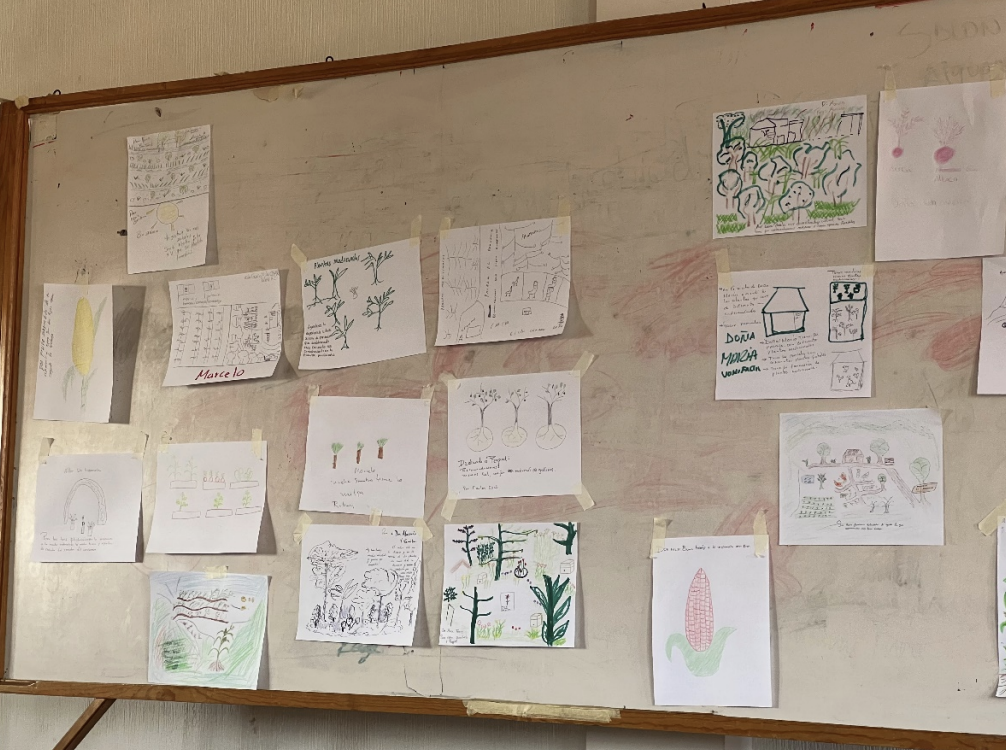Durante el inicio del día, recogimos algunas impresiones de la gira por las parcelas y reflexionamos sobre el impacto de la metodología Campesino a Campesino. Se resaltó la importancia de no utilizar un lenguaje técnico y hablar de manera apropiada para las comunidades. Se enfatizó en aprender a través del ejemplo y practicar juntos, en lugar de enseñar de forma unidireccional. Se hizo hincapié en que la diferencia entre un técnico y un promotor radica en que el conocimiento se construye colectivamente a través del trabajo conjunto. Se destacó que el promotor, al estar más cercano a las personas, tiene el papel de animar y acompañar.
En la metodología Campesino a Campesino, ni el técnico ni el promotor son más o menos importantes. El valor radica en la actitud, la seguridad y otros aspectos, no solo en el conocimiento. Se planteó la pregunta de si la educación tiene influencia y si la falta de educación es un problema que debe abordarse.
Se subrayó que el trabajo y el aprendizaje deben darse sin subestimar ni sobreestimar las capacidades de nadie, incluyendo a uno mismo. La idea es unirse para promover la agroecología y la permacultura.
En relación a la permacultura, se destacó que se ve como un sistema de vida que involucra a la familia, la biología y es una filosofía de vida que también considera situaciones de género. Se reflexionó sobre la importancia de no enfocarse únicamente en conceptos, términos y enfoques, sino en ponerlos en discusión. Se planteó que palabras como proyecto, programa, promotores y técnicos pueden convertirse en barreras que impiden el avance de las organizaciones en las comunidades.
Estas reflexiones en torno a la metodología Campesino a Campesino y la importancia de la permacultura resaltan la necesidad de utilizar un lenguaje adecuado, construir conocimiento colectivamente y superar las barreras conceptuales para promover una agricultura más sostenible y basada en principios de respeto hacia el entorno y la comunidad.

Jeff Bailey
I think a lot about joint pain and how to solve it—seems like everyone deals with it at some point, right? Whether it’s from old injuries, just getting older, or even something like arthritis, it’s tough to avoid. But here’s the thing: a lot of the pain we feel isn’t just from the wear and tear of the past. It’s also because we’re not moving in ways that our joints really need. – https://cutt.ly/geEIQm6A
I used to think I could blame my joint pain on all the sports I played back in the day, but it turns out, it’s not just about what I did. It’s about what I’m not doing now. Pain isn’t just a nuisance; it’s a signal that something’s off. And while meds can help temporarily, they don’t fix the underlying issue. I’ve learned that joints actually crave pressure—the right kind, of course. It’s this pressure that keeps them healthy and mobile.
I found a way to give my joints the attention they need without doing anything intense or painful. It’s all about slow, mindful movement that actually helps your body heal from the inside out. It’s not exercise in the traditional sense—no sweating or heavy breathing—just a gentle, consistent practice that’s made a world of difference for me.
What’s cool is that you don’t have to spend hours each day doing this. Just a little time, a few times a week, and you can start to see and feel the difference. I’ve seen it work wonders, even for people in their 70s and 80s.
Have you ever tried something like this for your joints? I’d love to chat and share what’s been working for me.
Talk soon,
Jeff Bailey
https://cutt.ly/geEIQm6A
Founder, Teacher Avita Yoga